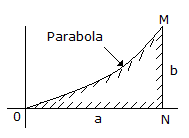Civil Engineering :: Applied Mechanics
-
Time of flight of a projectile on a horizontal plane, is
-
The reaction RB of the roller support B of the beam shown in below figure is
-
The acceleration of a train starting from rest at any instant is \( \frac { 1 } { 6(V+1) } m/sec^2\) where V is the velocity of the train in m/sec. The train will attain a velocity of 36 km/hour after travelling a distance of
-
The maximum frictional force which comes into play, when a body just begins to slide over the surface of a an other body, is known
-
If G is the Gauge of track, v is velocity of the moving vehicle, g is the acceleration due to gravity and r is the radius of a circular path, the required superelevation is
-
If two forces of 3 kg and 4 kg act at right angles to each other, their resultant force will be equal to
-
The c.g. of the shaded area of the below figure from the x-axis is

-
If v and ¬° are linear and angular velocities, the centripetal acceleration of a moving body along the circular path of radius r, will be
-
Two shots fired simultaneously from the top and bottom of a vertical tower with elevations of 30° and 45° respectively strike a target simultaneously. If horizontal distance of the target from the tower is 1000 m, the height of the tower is
-
For the given values of initial velocity of projection and angle of inclination of the plane, the maximum range for a projectile projected upwards will be obtained, if the angle of projection is


 Whatsapp
Whatsapp
 Facebook
Facebook

